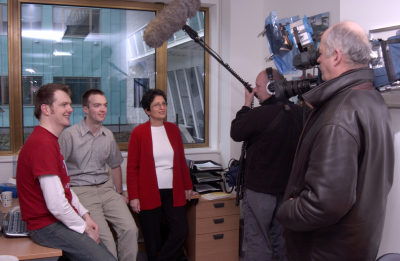Northern Lights on Channel Four

Farideh Honary and colleagues Dr Steve Marple,
Dr Jim Wild with Channel 4 film crew in InfoLab21.
Channel 4 came to Lancaster University this week to learn more about the Northern Lights - also known as Aurora Borealis.
Lancaster University's Department of Communication Systems operates a system known as ‘AuroraWatch’ which monitors geomagnetic activity for signs of Aurora Borealis and alerts people when the Northern Lights can be seen in the sky over Britain.
The University also manages a website which allows the public to monitor geomagnetic activity in real time.
Channel 4 wants to include the feature in an educational programme due to be broadcast in January next year.
‘In Search of 2005' is a five-part Channel 4 education series which will look at the 100 most searched words on the internet. Aurora Borealis was one of the top 100 most searched subjects in 2005.
The piece will be inserted into the programme - target audience 14 to 19 year olds - due to be broadcast in January.
As part of the programme the Channel 4 crew interviewed Professor Farideh Honary and other members of the AuroraWatch team from Lancaster University’s Department of Communications Systems.
Professor Honary, who leads Aurora Watch at Lancaster University, said: “Aurora Borealis is a spectacular natural phenomenon, which can occasionally be seen in the night sky over Britain. Once seen, it is never forgotten.
“The programme is aimed at young people and I hope what they see inspires them to take an interest in the night sky as well as giving them a glimpse of the breadth of study within Communication Systems.”
Lancaster University monitors geomagnetic activity with its UK Sub-Auroral Magnetometer Network (SAMNET) - an array of magnetometers scattered across the UK and northern Europe funded by Particle Physics and Astronomy Research Council (PPARC).
The data from the magnetometer is processed and made available on a web page. (http://www.dcs.lancs.ac.uk/iono/aurorawatch)